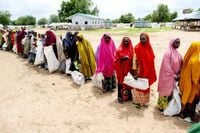Over 600 children have tragically died from malnutrition in northern Nigeria during the first half of 2025, as a dire humanitarian crisis worsens amid dwindling foreign aid, escalating violence, and economic hardship. According to Doctors Without Borders (MSF), the region is grappling with an alarming surge in malnutrition cases, complicated by ongoing insurgency and banditry.
MSF reported that from January to June 2025, their teams treated nearly 70,000 children for malnutrition in Katsina state alone, with almost 10,000 requiring hospitalization. Disturbingly, cases of nutritional oedema—the deadliest form of malnutrition—have surged by 208 percent compared to the same period in 2024. The charity confirmed that 652 children have already died in their facilities this year due to delayed access to care, a grim indicator of the crisis’ severity.
Ahmed Aldikhari, MSF’s country representative in Nigeria, emphasized the gravity of the situation, stating, “The true scale of the crisis exceeds all predictions.” He attributed the worsening conditions to massive cuts in foreign aid, particularly from the United States following President Donald Trump’s decision to slash overseas spending, as well as reductions from the United Kingdom and European Union. These funding shortfalls have coincided with rising living costs and intensified jihadist attacks, creating a perfect storm that has overwhelmed humanitarian efforts.
MSF’s survey of 750 mothers revealed that over half were acutely malnourished, with 13 percent suffering from severe acute malnutrition themselves—highlighting how deeply the crisis affects entire communities. Abdulhadi Abdulkadir, the Katsina state nutrition officer, acknowledged the seriousness of malnutrition but suggested that MSF’s numbers might be inflated, promising official statistics by early August. He noted that northern Katsina, bordering Niger and part of the semi-desert Sahel region, experiences the worst malnutrition due to harsh climate conditions limiting food production. Meanwhile, the southern part of the state, typically more fertile, faces challenges from criminal gangs known as bandits who raid villages, disrupting farming and food security.
Banditry has become a widespread problem across Nigeria, with kidnappings and violence targeting rural populations, further destabilizing food production and access. In response, the Katsina state government allocated 500 million naira (about $330,000) to nutrition programs in 2024 and has doubled this funding in 2025, reflecting growing concern at the governmental level.
Beyond Katsina, the malnutrition crisis extends across northern Nigeria’s dozen-plus states. The United Nations World Food Programme (WFP) estimates that nearly 31 million Nigerians face acute hunger, a record high for the country of approximately 230 million people. David Stevenson, WFP’s Nigeria country director, warned that the situation is deteriorating rapidly.
In the northeast, the humanitarian outlook is especially bleak. The town of Damboa, once a thriving farming hub located about 90 kilometers south of Maiduguri—the capital of Borno state—now sits on the frontline of survival. The area borders the Sambisa forest, a notorious jihadist stronghold. Since early 2025, jihadist attacks have escalated, with groups like Boko Haram and the Islamic State West Africa Province (ISWAP) becoming more organized and emboldened. This resurgence has stretched Nigeria’s security forces thin, compounded by a separate banditry crisis and economic hardships that fuel local grievances.
Residents like 25-year-old Almata Modu fled their villages after jihadists overran them, seeking refuge in Damboa. However, food rations there are meager and rapidly depleting. Modu told AFP, “We are safe, but the food is not enough.” Similarly, Aminata Adamu, who fled her home a decade ago, receives monthly rations for four registered family members despite now supporting eleven people. The strain on aid resources is palpable.
Western aid cuts, including the dismantling of the US Agency for International Development (USAID) under President Trump, have devastated humanitarian programs. Chi Lael, WFP’s Nigeria spokeswoman, pointed out that the “last rice from USAID” is being distributed, with no food left in warehouses. The WFP has been forced to announce it will suspend emergency food and nutrition aid for 1.3 million people in northeast Nigeria by the end of July 2025 due to critical funding shortfalls. This suspension threatens to leave millions starving during the “lean season” from June to September, when food reserves are naturally low between planting and harvest.
Economic inflation and forced displacement further limit farmers’ ability to purchase food, according to Diana Japaridze of the International Committee of the Red Cross. Vast swaths of farmland near Damboa have been abandoned due to violence, and a recent killing of a farmer in his field underscores the ongoing insecurity.
Malnutrition among children under five in Damboa is the highest and most severe in northeast Nigeria, said Kevin Akwawa, a doctor with the International Medical Corps. Mothers like 39-year-old Fanna Abdulraman bring severely malnourished infants to nutrition centers, but with 150 of the 500 WFP-supported centers slated to close due to lack of funds, the lives of approximately 300,000 children hang in the balance. Dr. John Ala, a WFP nutrition officer, warned that food shortages could exacerbate insecurity as desperate people resort to harmful coping mechanisms.
Fanna Mohammed, a mother of nine, was unaware that food aid and child nutrition treatments would soon end. She expressed a haunting sentiment: “I can’t imagine that we will live.”
A joint June-to-September outlook report by the WFP and Food and Agriculture Organization (FAO) projects worsening acute food insecurity driven by intensifying conflict, ongoing economic hardships, and expected flooding. The collapse of WFP operations in northeast Nigeria is not just a humanitarian crisis but a growing threat to regional stability, Stevenson stressed.
As the crisis deepens, the intersecting challenges of insurgency, banditry, economic collapse, and dwindling aid paint a grim picture for millions in northern Nigeria. The coming months will test the resilience of communities and the international community’s commitment to preventing further loss of life.

